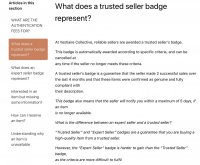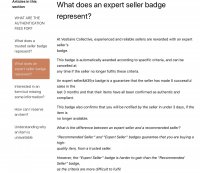I really enjoy buying and wearing great quality fashion. Everything I sell pretty much was brand new to me and is still unused, or a mistake I wore once. The trouble is that existence of VC makes me more likely to make poor buying decisions because I know I can recoup some of the outlay, though I know I’ll lose money, and I’m a little in denial by avoiding putting figures on it. It won’t break the bank, I don’t spend what I can’t afford, but still I am aware I’m being a bit wasteful and casual. I want to tighten that up, and I have done to a great extent, you are not alone in this! It is a bit depressing to waste hard earned money, affordable or not. So I think you did a very wise thing by making yourself look at the sobering figures, and concentrating on getting your reward instead from buying things that make you pause a little more before impulse buying.
I do think I kid myself a bit when it comes to how much I might be able to recoup and how far that mitigates ill-judged purchases. At least I feel I never kid myself that I’m buying things as an investment, though. There’s no such thing in the fashion world, I would think, apart from the odd very limited edition or iconic vintage piece, or maybe the whole Kelly/Birkin thing (off-topic: which I avoid and don’t know a lot about, because I feel Hermès maybe manipulates customers a bit more than I’m comfortable with. The bags are very nice, I can understand wanting one, but I don’t really want to ‘develop a relationship’ with an SA or boutique. Maybe it’s not really necessary to do that, I’m only going by what I read on TPF which may be an unbalanced picture. I don’t want to pay over the odds for a pre-owned Hermès, either, really, but I expect I would if I really hankered after one. I do understand it, they are lovely bags, it just happens I’m more of a
Fendi person). Gabs’s special classic vintage items she mentioned in her post to Oikasecondhand might be investments, that sort of thing. And actually it still makes sense that when buying higher end things at least you can recoup
some money, and as we’ve all said before, they hopefully impact the environment a little less, even if the ‘investment’ argument holds little water. I think it just helps to develop self awareness, about how often you’re doing it and when it’s gone too far. I think you’ve been quite brave, checking the figures! It gives you an objective handle on it.
One of my worst habits: buying the same thing in two sizes. My weight fluctuates a lot for health reasons. Sometimes I get two sizes of a skirt or trousers or dress, because I’ve also bought the top or jacket or shoes or bag to wear with them, which are generally more amenable to size changes, so I only got those items in one size, and I think I want to be able to wear the whole outfit in the event of fluctuations. So I basically tell myself it’s ‘an investment’ to buy the additional skirt/trousers/dress, in that it means I will be able to make more use out of the other bits. It’s an in-demand new piece and I won’t be able to get the other size later if I decide I need it, I tell myself. Then I realise I don’t really like the outfit in the bigger size anyway. So I eventually end up selling it, unworn, with tags, at a loss. I should recognise how often this happens and just stop doing it. It’s been quite rare I’ve actually made use of both sizes. I do not like the same clothes sized up from when I’m an Italian 44 to when I’m an Italian 46, or vice versa. I like different sorts of clothes when I’m a different size. It’s way past time I applied this knowledge with a little more consistency to my actions!




